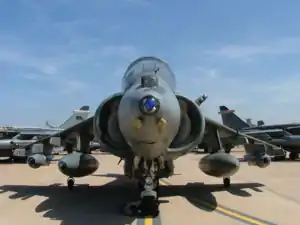AN/ASB-19
The Hughes AN/ASB-19 Angle Rate Bombing System (ARBS) is an avionics system originally designed for US Marine Corps attack aircraft to improve day and night bombing accuracy when operating in the close support role using unguided weapons. Externally or nose mounted, ARBS is a target designator which weighs less than 63 kg (140 lb) and includes an automatic laser tracking system and a pilot-controlled tracking television, both using a common optical system.

Operations
A pilot used the ARBS to identify ground targets on a TV display, then locks on the TV tracker. For laser-designated targets the tracker scans ahead of the aircraft and automatically locks on to the designated target, which can be illuminated by a ground-based or airborne laser. In daytime the pilot can opt at any time to switch from laser to TV tracking. The pilot then followed the steering instructions presented in the Head-up display or optical sight and when the computer detected an acceptable combination of dive angle and tracker angle rate the ordnance was released automatically.
The system was used on the USMC A-4M Skyhawk & AV-8B Harrier II, the Spanish Navy AV-8B Harrier II, and during the 1999 NATO bombing of Yugoslavia by Royal Air Force Harrier GR7s.
References
"the aircraft every air force wants". FLIGHT International: 1146. 15 October 1977. Retrieved 2012-11-28. Svenska Radio of Sweden asked the display systems laboratory at Hughes (Culver City, California 90230) to devise a miniature display for use with the Maverick missile. The resulting EP-13 virtual-image display consists of a one inch cathode-ray tube (CRT) and magnifying optics which project the resulting image at an apparent distance of 48in from the pilot's eyes.
